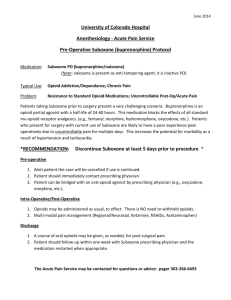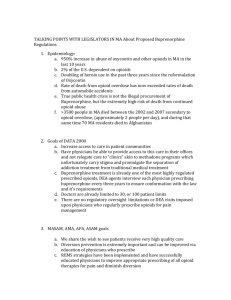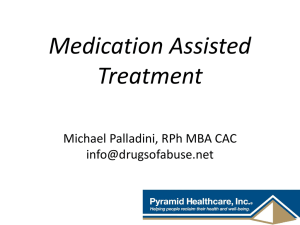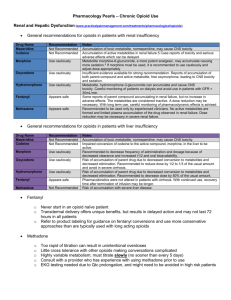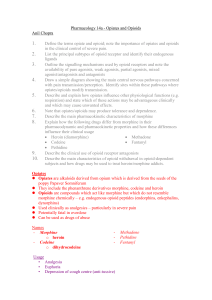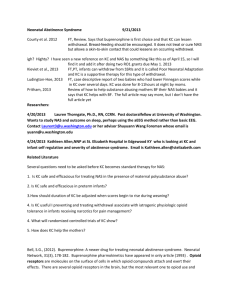Opioid Selection
advertisement
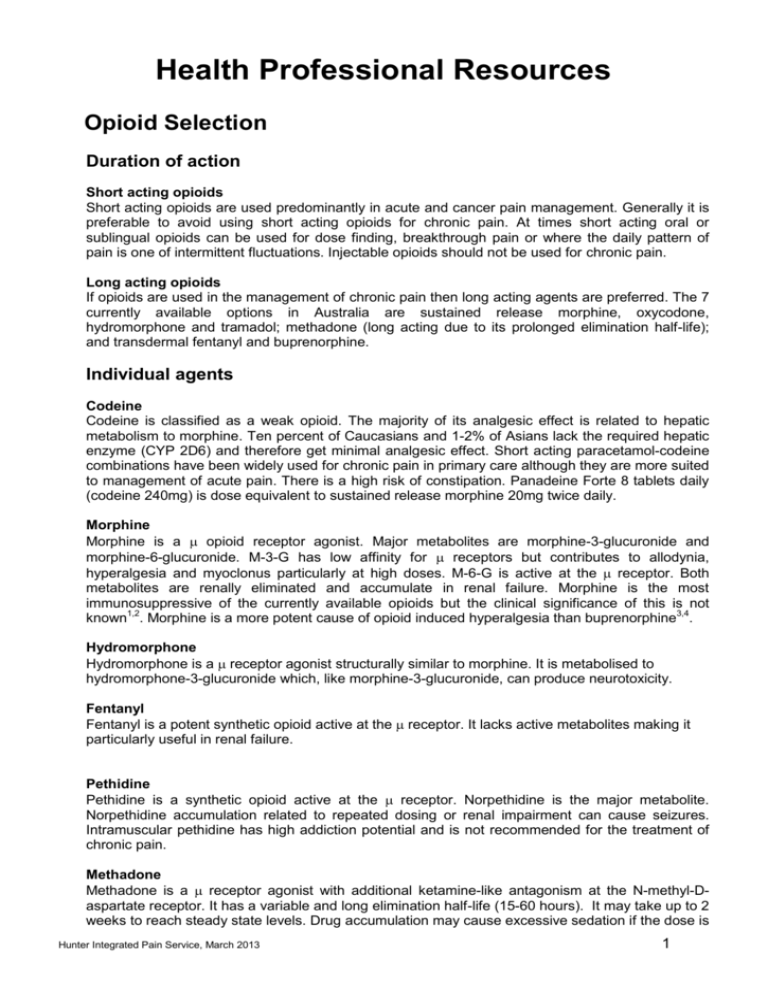
Health Professional Resources Opioid Selection Duration of action Short acting opioids Short acting opioids are used predominantly in acute and cancer pain management. Generally it is preferable to avoid using short acting opioids for chronic pain. At times short acting oral or sublingual opioids can be used for dose finding, breakthrough pain or where the daily pattern of pain is one of intermittent fluctuations. Injectable opioids should not be used for chronic pain. Long acting opioids If opioids are used in the management of chronic pain then long acting agents are preferred. The 7 currently available options in Australia are sustained release morphine, oxycodone, hydromorphone and tramadol; methadone (long acting due to its prolonged elimination half-life); and transdermal fentanyl and buprenorphine. Individual agents Codeine Codeine is classified as a weak opioid. The majority of its analgesic effect is related to hepatic metabolism to morphine. Ten percent of Caucasians and 1-2% of Asians lack the required hepatic enzyme (CYP 2D6) and therefore get minimal analgesic effect. Short acting paracetamol-codeine combinations have been widely used for chronic pain in primary care although they are more suited to management of acute pain. There is a high risk of constipation. Panadeine Forte 8 tablets daily (codeine 240mg) is dose equivalent to sustained release morphine 20mg twice daily. Morphine Morphine is a opioid receptor agonist. Major metabolites are morphine-3-glucuronide and morphine-6-glucuronide. M-3-G has low affinity for receptors but contributes to allodynia, hyperalgesia and myoclonus particularly at high doses. M-6-G is active at the receptor. Both metabolites are renally eliminated and accumulate in renal failure. Morphine is the most immunosuppressive of the currently available opioids but the clinical significance of this is not known1,2. Morphine is a more potent cause of opioid induced hyperalgesia than buprenorphine3,4. Hydromorphone Hydromorphone is a receptor agonist structurally similar to morphine. It is metabolised to hydromorphone-3-glucuronide which, like morphine-3-glucuronide, can produce neurotoxicity. Fentanyl Fentanyl is a potent synthetic opioid active at the receptor. It lacks active metabolites making it particularly useful in renal failure. Pethidine Pethidine is a synthetic opioid active at the receptor. Norpethidine is the major metabolite. Norpethidine accumulation related to repeated dosing or renal impairment can cause seizures. Intramuscular pethidine has high addiction potential and is not recommended for the treatment of chronic pain. Methadone Methadone is a receptor agonist with additional ketamine-like antagonism at the N-methyl-Daspartate receptor. It has a variable and long elimination half-life (15-60 hours). It may take up to 2 weeks to reach steady state levels. Drug accumulation may cause excessive sedation if the dose is Hunter Integrated Pain Service, March 2013 1 increased rapidly. The dose can generally be increased on a weekly basis. Methadone has no active metabolites. Methadone can cause prolongation of QT interval and hence cardiac arrhythmias. Recent safety recommendations advise pre-treatment ECG screening to measure QT interval and a repeat ECG within 3 months and then annually5. Two formulations are available in Australia. Methadone liquid is used in opioid substitution programs with once daily dosing to prevent withdrawal in opioid addicted patients. Methadone tablets are typically used twice daily to manage chronic pain. Oxycodone The analgesic action of oxycodone appears to be mediated primarily by receptor agonism6 with lesser activity at and receptors. Oxycodone metabolites are only weakly active. Targin is a new oral agent containing sustained release oxycodone and naloxone. The naloxone component blocks opioid induced constipation but does not reverse analgesia due to its high first pass hepatic metabolism. Buprenorphine Buprenorphine is a partial agonist at opioid receptors and an antagonist at and receptors. It binds strongly to the receptor site but does not fully activate it. Drug interactions can therefore occur when buprenorphine is combined with pure agonists. If buprenorphine is administered to a person on a maintenance pure agonist then a withdrawal reaction can be precipitated. Conversely, if pure agonists are administered to a person on maintenance buprenorphine then the pure agonist may be less effective due to reduced access to the receptor site. However these interactions are dose related with animal7 and human8 models showing effectiveness of breakthrough pure agonists during buprenorphine maintenance in the usual analgesic dose range. In clinical practice these drug interactions may occur with the high buprenorphine doses used in the management of addiction but are very unlikely at buprenorphine doses used for analgesia. Tramadol Tramadol can be classified as a weak opioid and has agonist activity at the receptor. It is converted to its more active metabolite (O-desmethyltramadol) in the liver by isoenzymes including CYP 2D6. Additional analgesia comes from serotonin and noradrenalin reuptake inhibition. Tramadol causes less constipation than other opioids. Drug interaction with other serotonin active agents (eg. selective serotonin reuptake inhibitors) can cause serotonin toxicity with central nervous system excitation. Nevertheless tramadol can be used with caution in combination with SSRI’s. Specific considerations Neuropathic pain Antidepressants and anticonvulsants are used as first and second line therapies for neuropathic pain either alone or in combination. Opioids are generally used as third line therapy9. Oxycodone (primarily receptor agonist), methadone ( and NMDA receptor activity) and tramadol ( receptor agonist and reuptake inhibitor of serotonin and noradrenalin) may be more effective than pure receptor agonists such as morphine. Buprenorphine (partial agonist and and antagonist) may also have advantages in this situation due to its antihyperalgesic effect. Immune system i. ii. Opioids have been shown to cause immunosuppression in both animal and human studies, however the clinical significance of this is unclear1,2. Opioids can be grouped according to degree of immunosuppression as shown below. There are theoretical advantages in avoiding more immunosuppressant opioids in patients with cancer, trauma, immunocompromise and major surgery. Hunter Integrated Pain Service, March 2013 2 Table 1. Opioid induced immunosuppression Marked immunosuppression Morphine Moderate immunosuppression Codeine Fentanyl Methadone Pethidine Minimal immunosuppression Buprenorphine Hydromorphone Oxycodone Tramadol Renal Impairment In renal impairment accumulation of metabolites can cause adverse effects: i. Morphine to M3G (neuroexcitation) and M6G (analgesia and sedation) ii. Hydromorphone to H3G (neuroexcitation) iii. Pethidine to norpethidine (neuroexcitation) iv. Oxycodone and buprenorphine – metabolites only weakly active v. Methadone and fentanyl have no active metabolites Table 2. Oral and transdermal opioids available in Australia Generic name Long acting agents Short acting agents Morphine MS Contin tabs 5,10,15,30,60,100,200mg MS Mono caps 30,60,90,120mg Kapanol caps 10,20,50,100mg Oxycontin tabs 5,10,15, 20, 30, 40, 80mg Targin tabs (oxycodone/naloxone) 5/2.5, 10/5, 20/10, 40/20mg Ordine liquid 1,2,5,10 mg/ml Sevredol tabs 10,20 mg Anamorph tabs 30 mg Endone tabs 5 mg Oxynorm caps 5,10,20 mg and liquid 1,10 mg/ml Proladone suppositories 30 mg Oxycodone Methadone Hydromorphone Physeptone tabs 10mg Jurnista 4, 8, 16, 32, 64mg Fentanyl Buprenorphine Tramadol Durogesic patch 12, 25,50,75,100mcg/hr Norspan patch 5, 10, 20mcg/hr Tramal SR tabs 100, 150, 200mg Durotram XR 100, 200, 300mg Dilaudid tabs 2,4,8 mg and liquid 1 mg/ml Temgesic sublingual tabs 200 mcg Tramal caps 50 mg References 1. Vallejo R, De Leon-Casasola O, Benyamin R. Opioid therapy and immunosuppression. Amer J Therap 2004;11:354-365 2. Budd K. Pain management: is opioid immunosuppression a clinical problem? Biomedicine and Pharmacotherapy 2006;60(7): 310-317 3. Simmonet G. Editorial. Opioids: from analgesia to anti-hyperalgesia. Pain 2005;118:8-9 4. Koppert W, Ihmsen H, Korber N et al. Different profiles of buprenorphine-induced analgesia and antihyperalgesia in a human pain model. Pain 2005;118:15-22 5. Krantz MJ, Martin J, Stimmel B et al. QTc interval screening in methadone treatment. Ann 2009;150(6):387-395. 6. Ross FB, Smith MT. The intrinsic antinociceptive effects of oxycodone appear to be kappareceptor mediated. Pain 1997;73:151-157 7. Kogel B, Christoph T, Straburger W et al. Interaction of mu-receptor agonists and antagonists with the analgesic effect of buprenorphine in mice. Euro J Pain 2005;9:599-611 8. Mercandante S, Villari P, Porzio G et al. Safety and effectiveness of intravenous morphine for episodic breakthrough pain in patients receiving transdermal buprenorphine. J Pain Sympt Manag 2006;32:175-179 9. Finnerup N B, Otto M, McQuay H J, Jensen T S et al. Algorithm for neuropathic pain treatment: an evidence based proposal. Pain 2005;118:289-305 Hunter Integrated Pain Service, March 2013 3
